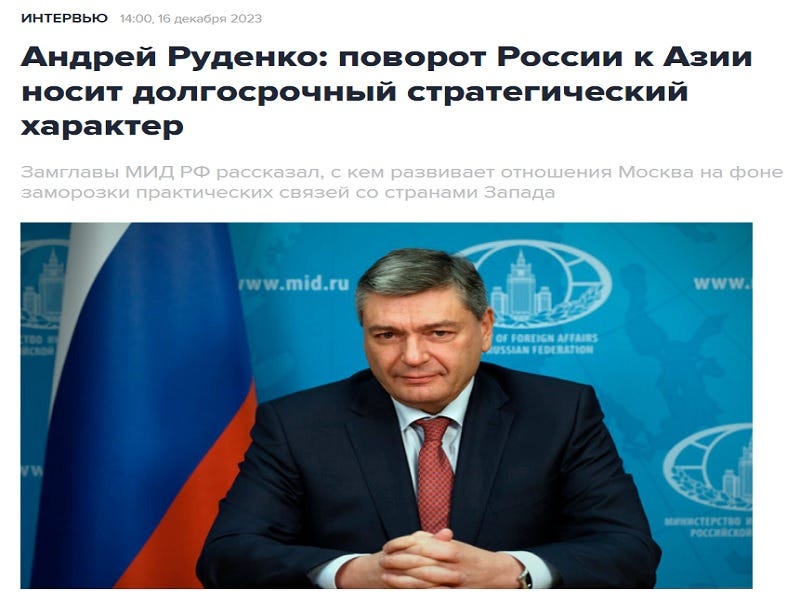Russia’s Top Asian Policymaker Shared Updates About The Greater Eurasian Partnership
The Eurasian Economic Union’s dual pairings with BRI and the NSTC will unleash the supercontinent’s full economic potential with time in a way that also crucially maintains the strategic balance between China and India.
Deputy Foreign Minister Andrey Rudenko, who’s Russia’s top Asian policymaker, shared updates from the past year about his country’s Greater Eurasian Partnership in his latest interview with Interfax. He began by explaining how this geopolitical direction has always been a priority for Moscow even before the special operation but became more important than ever in the nearly 23 months since it began. Ties with China are especially significant since they blunted the economic impact of reduced EU trade.
Rudenko also reaffirmed that the Greater Eurasian Partnership is premised on connecting the Russian-led Eurasian Economic Union (EAEU) with China’s Belt & Road Initiative (BRI), though it would be wrong for observers to speculate that this vision has impeded the expansion of ties with India. Although that globally influential Great Power doesn’t participate in BRI and is at loggerheads with China over their disputed border, relations with Russia have comprehensively expanded over the past year.
It’s not directly stated, but astute observers can read between the lines to intuit that Russia is informally relying on India to preemptively avert any potentially disproportionate dependence on China, which accounts for the equal amount of attention that he gave to both countries in his interview. The North-South Transport Corridor (NSTC) that Russia is constructing with India runs through Iran, and this provided a strong impetus for developing bilateral relations with Tehran over the past year too.
Other countries that Rudenko pointed out had improved their ties with Russia during this time include North Korea, Mongolia, and Pakistan. The first’s leader met with President Putin a few months back in what Russia’s top Asian diplomat described as an historic summit, the second country is his own’s traditional partner, while the third is a non-traditional one that’s interested in energy and logistical ties. A few positive words about ASEAN as a whole then rounded out the positive news that he shared.
As for the setbacks that Russia experienced over the past year, Rudenko lamented the unfriendly approach of some unnamed ASEAN states (likely a reference to Singapore’s compliance with Western sanctions), Australia, Japan, New Zealand, and South Korea. Nevertheless, he said that his country isn’t interested in curtailing political ties since maintaining a diplomatic presence enables it “to clearly and reasonably convey to the leadership of foreign countries our position on key issues” as he phrased it.
Taken together, it’s clear that “The US Failed To Drive A Wedge Between Russia & Its Asian Partners” exactly as Rudenko himself noted almost a year back in an interview that he gave to Izvestia last January. The reason for this is that the sovereignty has indeed become the zeitgeist of the emerging Multipolar World Order just like President Putin observed in summer 2022. While some states continue languishing in servitude to the West, most are actively strengthening their strategic autonomy right now.
To that end, they’re expanding ties with Russia since their policymakers correctly assess that this will help them either reduce their already disproportionate dependence on the West or preemptively avert it sometime in the future, all with a view towards accelerating multipolar processes in Eurasia. In practical terms, the EAEU’s dual pairings with BRI and the NSTC will unleash the supercontinent’s full economic potential with time in a way that also crucially maintains the strategic balance between China and India.
This reading of Russia’s intentions is based on its leader’s speech at October’s BRI Forum, during which time “Putin Suggested That Chinese & Indian Investments In Russia Advance Shared Multipolar Goals”. Upon dwelling more deeply on what he said, it was concluded that “Russia’s Sino-Indo Balancing Act Has An Increasingly Important Infrastructure Component”. This grand strategic imperative is what really drives Russia’s Greater Eurasian Partnership, and readers can see its influence in Rudenko’s interview.



